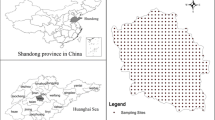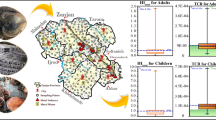Abstract
To explore mutual relationship among soil characteristics (soil organic matter, soil texture, cation exchange capacity, and pH), land uses, toxic metal (As, Hg, Mn, and Ni) distributions and induced health risk, 156 topsoil samples (0–20 cm) were collected from farm land, forest land and construction land in a grid pattern throughout Xiandao District. Compared with Hunan soil background values, the elevated concentrations of As, Hg and Ni were found to different extent. Pearson correlation matrix suggested As-silt, Mn-Ni, CEC-Mn, CEC-Ni, and CEC-pH had significantly positive correlation, and significantly negative correlation existed in SOM-pH, CEC-clay, SOM-Ni, and SOM-pH. Results based on the soil texture analysis, analysis of variance, and Tukey test indicated the concentrations of As and Ni were higher in relatively fine textures, and the mean contents of As, Mn, Ni, pH, and SOM in construction land, construction land, construction land, forest land, and construction land, respectively, were with the significant difference from that in the other two land uses. For non-carcinogenic effects, Hazard Indexes (HIs) of Ni, Hg, Mn, and As decreased in the order of As > Hg > Mn > Ni to both children and adults. Risk contributions of each exposure pathway decreased in the order of ingestion > dermal contact > inhalation of resuspended particles for HIAs, HIMn, and HINi. The inhalation of vapors was the highest contributor for HIHg, followed by ingestion, dermal contact, and inhalation of resuspended particles. As and Hg were regarded as the priority pollutants. The hierarchical risk areas were identified after comprehensive consideration of local residential population density distribution, and the different risk management measures were finally suggested for the different priority areas.






Similar content being viewed by others
References
Chai L, Wang Z, Wang Y, Yang Z, Wang H, Wu X (2010) Ingestion risks of metals in groundwater based on TIN model and dose-response assessment—a case study in the Xiangjiang watershed, central-south China. Sci Total Environ 408(16):3118–3124
Chen HM (2010) Environmental soil science, 2nd edn. Science Press, Beijing (in Chinese)
Chen JQ, Wang ZX, Wu X, Zhu JJ, Zhou WB (2011) Source and hazard identification of heavy metals in soils of Changsha based on TIN model and direct exposure method. T Nonferr Metal Soc 21(3):642–651
CNEMC (China National Environmental Monitoring Center) (1990) Background values of soil elements in China, 1st edn. Chinese Environmental Science Press, Beijing (in Chinese)
Duker AA, Carranza EJM, Hale M (2005) Arsenic geochemistry and health. Environ Int 31(5):631–641
Gay JR, Korre A (2006) A spatially-evaluated methodology for assessing risk to a population from contaminated land. Environ Pollut 142(2):277–234
Hendershot WH, Lalande H, Duquette M (1993) Ion exchange and exchangeablecations. In: Carter MR (ed) Soil sampling and methods of analysis for Canadian Society of Soil Science. Lewis, Boca Raton, pp 141–145
Jiang M, Zeng G, Zhang C, Ma X, Chen M, Zhang J, Lu L, Yu Q, Hu L, Liu L (2013) Assessment of heavy metal contamination in the surrounding soils and surface sediments in Xiawangang River, Qingshuitang District. PLoS One 8(8):e71176
Li F, Huang J, Zeng G, Yuan X, Liang J, Wang X (2012) Multimedia health impact assessment: a study of the scenario-uncertainty. J Cent South Univ 19(10):2901–2909
Li F, Huang J, Zeng G, Yuan X, Li X, Liang J, Wang X, Tang X, Bai B (2013) Spatial risk assessment and sources identification of heavy metals in surface sediments from the Dongting Lake, Middle China. J Geochem Explor 132:75–83
Li X, Yuan X, Su X, Zhang P, Niu C, Yang C, Huang J, Zeng G (2014) Ecology, production, living space: development strategic planning environmental impact assessment. Hunan University Press, Changsha (in Chinese)
Li F, Huang J, Zeng G, Huang X, Liu W, Wu H, Yuan Y, He X, Lai M (2015) Spatial distributions and health risk assessment of heavy metals associated with receptor population density in street dust: a case study of Xiandao District, Middle China. Environ Sci and Pollut R. doi: 0.1007/s11356-014-3753-3
Luo XS, Yu S, Li XD (2011) Distribution, availability, and sources of trace metals in different particle size fractions of urban soils in Hong Kong: implications for assessing the risk to human health. Environ Pollut 159(5):1317–1326
Luo XS, Ding J, Xu B, Wang YJ, Li HB, Yu S (2012a) Incorporating bioaccessibility into human health risk assessments of heavy metals in urban park soils. Sci Total Environ 424:88–96
Luo XS, Yu S, Zhu YG, Li XD (2012b) Trace metal contamination in urban soils of China. Sci Total Environ 421–422:17–30
Mandal BK, Suzuki KT (2002) Arsenic round the world: a review. Talanta 58(1):201–235
MAPRC (2006) Soil testing (NY/T 1121.1∼12-2006). Ministry of Agriculture of the People's Republic of China, Beijing (in Chinese)
MEPPRC (1995) Environmental quality standard for soils (GB 15618-1995). Ministry of Environmental Protection of the People’s Republic of China, Beijing (in Chinese)
MEPPRC (1997) Soil quality determination of Ni: Flame atomic absorption spectrophotometry (GB/T 17139-1997). Ministry of Environmental Protection of the People’s Republic of China, Beijing (in Chinese)
MEPPRC (2014) Technical guidelines for risk assessment of contaminated sites (HJ 25.3–2014). Ministry of Environmental Protection of the People’s Republic of China, Beijing (in Chinese)
Miller JE, Hassett JJ, Koeppe DE (1975) The effect of soil properties and extractable lead levels on lead uptake by soybean. Commun Soil Sci Plant Anal 6(4):339–347
Nelson DW, Sommers LE (1982) Total carbon, organic carbon and organic matter. In: Page AL, Miller RH, Keeny DR (eds) Methods of soil analysis, part 2, chemical and microbiologiacl properties, 2nd edn. American Society of Agronomy, Inc, Madison
Nezhad MTK, Mohammadi K, Gholami A, Hani A, Shariati MS (2014) Cadmium and mercury in topsoils of Babagorogor watershed, western Iran: distribution, relationship with soil characteristics and multivariate analysis of contamination sources. Geoderma 219–220:177–185
Pan YM, Yang GZ (1988) Hunan soil background values and research methods. Chinese Environmental Science Press, Beijing (in Chinese)
Papa S, Bartoli G, Pellegrino A, Fioretto A (2010) Microbial activities and trace element contents in an urban soil. Environ Monit Assess 165(1–4):193–203
Peña-Fernández A, Lobo-Bedmar MC, González-Muñoz MJ (2015) Annual and seasonal variability of metals and metalloids in urban and industrial soils in Alcalá de Henares (Spain). Environ Res 136:40–46
Qishlaqi A, Moore F, Forghani G (2009) Characterization of metal pollution in soils under two landuse patterns in the Angouran region, NW Iran: a study based on multivariate data analysis. J Hazard Mater 172(1):374–384
Singh R, Gautam N, Mishra A, Gupta R (2011) Heavy metals and living systems: an overview. Indian J Pharm 43(3):246–253
Tang R, Ma K, Zhang Y, Mao Q (2013) The spatial characteristics and pollution levels of metals in urban street dust of Beijing, China. Appl Geochem 35:88–98
Tessier A, Campbell PGC, Bisson M (1979) Sequential extraction procedure for the speciation of particulate trace metals. Anal Chem 51:844–851
US Department of Energy (2004) RAIS: risk assessment information system. US Department of Energy, Washington DC
USEPA (1996) Soil screening guidance: technical background document (EPA/540/R–95/128). US Environmental Protection Agency, Washington DC
USEPA (2002) Supplemental guidance for developing soil screening levels for superfund sites (OSWER 9355.4–24). US Environmental Protection Agency, Washington DC
Van den Berg R (1994) Human exposure to soil contamination: a qualitative and quantitative analysis towards proposals for human toxicological intervention values. Report No.725201011. National Institute for Public Health and the Environment, Bilthoven
Wang Z, Chai L, Yang Z, Wang Y, Wang H (2010) Identifying sources and assessing potential risk of heavy metals in soils from direct exposure to children in a mine-impacted city, Changsha, China. J Environ Qual 39(5):1616–1623
Wang M, Bai Y, Chen W, Markert B, Peng C, Ouyang Z (2012) A GIS technology based potential eco-risk assessment of metals in urban soils in Beijing, China. Environ Pollut 161:235–242
Wang XT, Chen L, Wang XK, Lei BL, Sun YF, Zhou J, Wu MH (2015) Occurrence, sources and health risk assessment of polycyclic aromatic hydrocarbons in urban (Pudong) and suburban soils from Shanghai in China. Chemosphere 119:1224–1232
Wei B, Yang L (2010) A review of heavy metal contaminations in urban soils, urban road dusts and agricultural soils from China. Microchem J 94(2):99–107
Wu QH, Dai TG, Fang JW, Zhang JX, Xing XD, Guo DL (2007) Sources of heavy metals in soils of Changsha, Zhuzhou and Xiangtan, Hunan, China. Geol Bull China 26(11):1453–1458 (in Chinese)
Wu S, Peng S, Zhang X, Wu D, Luo W, Zhang T, Zhou S, Yang G, Wan H, Wu L (2015) Levels and health risk assessments of heavy metals in urban soils in Dongguan, China. J Geochem Explor 148:71–78
Xi D, Sun Y, Liu X (2004) Environmental monitoring, 3rd edn. Higher Education Press, Beijing (in Chinese)
Xia X, Chen X, Liu R, Liu H (2011) Heavy metals in urban soils with various types of land use in Beijing, China. J Hazard Mater 186(2–3):2043–2050
Xu J, Bravo AG, Lagerkvist A, Bertilsson S, Sjöblom R, Kumpiene J (2015) Sources and remediation techniques for mercury contaminated soil. Environ Int 74:42–53
Xue JL, Zhi YY, Yang LP, Shi JC, Zeng LZ, Wu LS (2014) Positive matrix factorization as source apportionment of soil lead and cadmium around a battery plant (Changxing County, China). Environ Sci Pollut Res 21(12):7698–7707
Ye X, Qian H, Xu P, Zhu L, Longnecker MP, Fu H (2009) Nephrotoxicity, neurotoxicity, and mercury exposure among children with and without dental amalgam fillings. Int J Hyg Environ Health 212(4):378–386
Zhai Y, Liu X, Chen H, Xu B, Zhu L, Li C, Zeng G (2014) Source identification and potential ecological risk assessment of heavy metals in PM2.5 from Changsha. Sci Total Environ 493:109–115
Zhao L, Xu Y, Hou H, Shangguan Y, Li F (2014) Source identification and health risk assessment of metals in urban soils around the Tanggu chemical industrial district, Tianjin, China. Sci Total Environ 468–469:654–662
Zheng N, Liu J, Wang Q, Liang Z (2010) Health risk assessment of heavy metal exposure to street dust in the zinc smelting district, Northeast of China. Sci Total Environ 408(4):726–733
Acknowledgments
This study was financially supported by the National Natural Science Foundation of China (51178172, 51039001, 51308076, and 51378190), the Project of Chinese Ministry of Education (113049A) and the Research Fund for the Program for Changjiang Scholars and Innovative Research Team in University (IRT-13R17).
Author information
Authors and Affiliations
Corresponding authors
Additional information
Responsible editor: Zhihong Xu
Rights and permissions
About this article
Cite this article
Li, F., Huang, J., Zeng, G. et al. Toxic metals in topsoil under different land uses from Xiandao District, middle China: distribution, relationship with soil characteristics, and health risk assessment. Environ Sci Pollut Res 22, 12261–12275 (2015). https://doi.org/10.1007/s11356-015-4425-7
Received:
Accepted:
Published:
Issue Date:
DOI: https://doi.org/10.1007/s11356-015-4425-7




